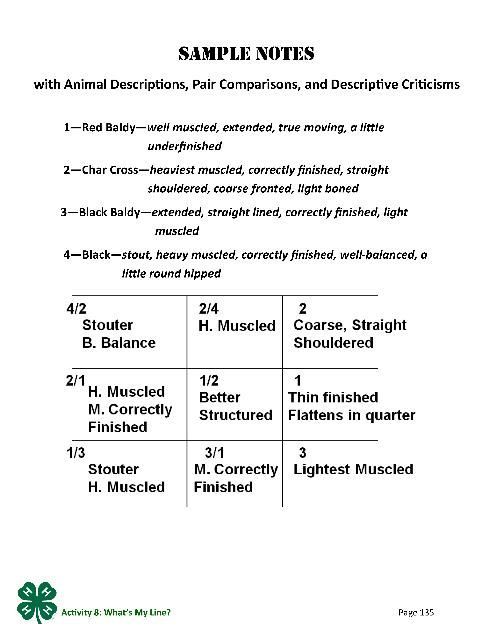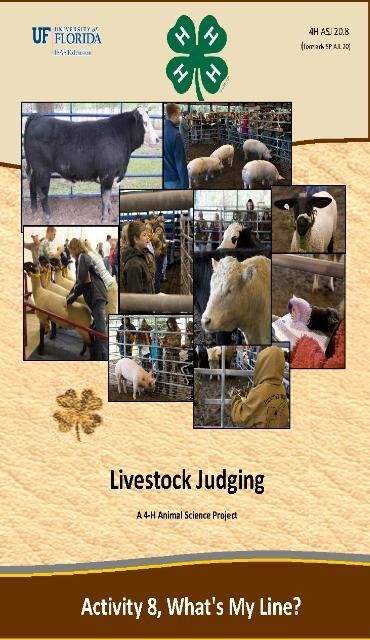
Credits and Acknowledgements
4-H LIVESTOCK JUDGING was developed through a team effort with the Florida 4-H Youth Development Program, Department of Family, Youth and Community Sciences, and the Department of Animal Science, The Institute of Food and Agricultural Sciences, University of Florida.
This edition of the Livestock Judging curriculum package was created by Chad Carr, Assistant Professor; Justin Crosswhite, Graduate Assistant; and Amanda Johnson, Undergraduate Assistant, Department of Animal Sciences. Authors of previous editions include: Julie Sexton and Karen Strickland, former Project Assistants; Allen Stateler, former Graduate Assistants; Saundra TenBroeck, Associate Professor and Youth Livestock Extension Specialist, Department of Animal Sciences; Tim Marshall, Associate Professor, Department of Animal Sciences; and Deborah J. Glauer, Extension Youth Development Specialist and Animal Science Design Team Leader, Department of Family, Youth and Community Sciences.
Technical review and assistance for this edition was provided by members of the 4-H Life Skills Animal Science Action Team—Amanda Thein, Nassau County 4-H Agent, Chris DeCubelis, Gilchrist County 4-H Agent, and Joy C. Jordan, Associate Professor 4-H Youth Development Curriculum Specialist, Department of Family, Youth and Community Sciences, University of Florida, Institute of Food and Agricultural Sciences.
Activity 8
For youth to:
Develop note taking skills.
Identify the importance of oral reasons.
Follow the format of oral reasons.
Analyze the different styles of oral reasons.
Develop skill in presentation of oral reasons.
Communicating and relating to others.
Acquiring, analyzing and using information.
Copies of blank TAKING NOTES
Handout for each youth
Copies of TAKING NOTES Handout for each youth
Copies of MAJOR SPEAK UP
Points for each youth
Copies of REASONS FORMAT for each youth
Pens/pencils
Sunglasses (4 different types)
Depends on number of judging members
Comfortable room
What's My Line?
Background Basics
In judging, oral reasons enable the participants to express their opinions and knowledge about the animals they previously placed. Teams and members which strive for excellence in oral reasons usually outscore other teams and gain more overall knowledge from the judging opportunities. On the surface, reasons involve telling someone how and why a class of animals were placed the way they were. However, reasons communicate more about oneself than you realize: The industry knowledge, confidence level, ability to solve problems and perhaps most importantly, the ability to express truthful views on a subject.
In the competitive job market of today, many corporate executives cite communication skills as the most lacking skill of job applicants. We are very fortunate in livestock judging to have a tool which can cultivate confidence and aptitude in oral presentation: oral reasons.
Giving reasons will help youth to:
- Develop a system for analyzing a class of livestock
- Think clearly on their feet
- State their thoughts clearly
- Improve their speaking, poise, and presentation
- Develop their memory
Taking Notes
Unless youth have a photographic memory, accurate and complete note taking is imperative to the presentation of oral reasons. There are several hours between the actual viewing of a class and the presentation of the oral reasons on that class. Therefore, notes that are complete and accurate are vital in order to recall the image of the class in the member's mind.
There are many different methods of note taking, and the method used by each member should be what he/she is most comfortable using. However, there is a basic format which should be used. Due to time constraints on each class, members should develop their own shorthand for taking notes. The less time spent on taking notes, the more time available for decision making.
The standard format for taking notes can be found on the TAKING NOTES HANDOUT.
Format
Reasons should be organized, logical and easy to listen to. The following format will help students to organize their thoughts and to present them with confidence.
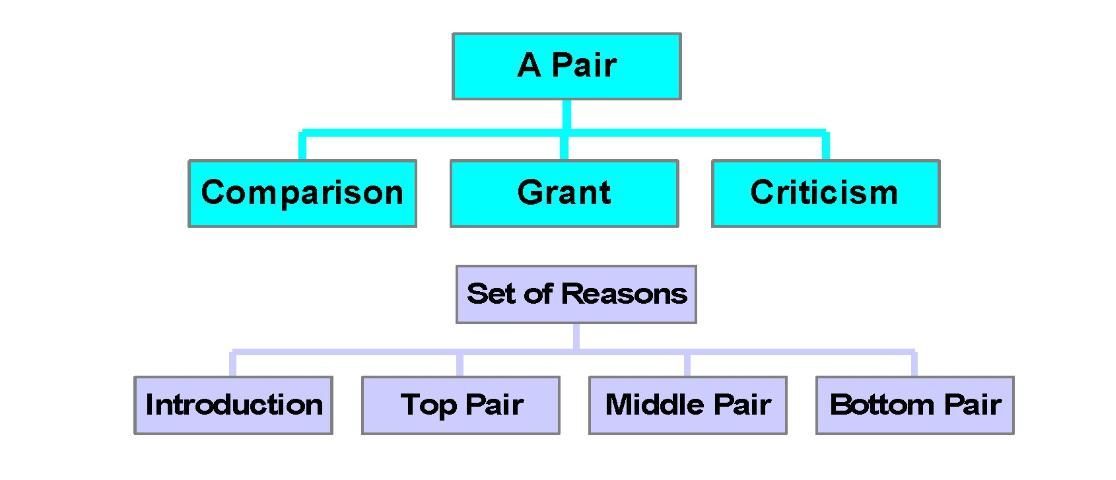
Outline for a Set of Reasons
- Opening Statement
- Name of class
- Placing
- Superlative statement about the top animal
- Descriptive criticism of the top animal
- Top Pair
- Talk 1st over 2nd using comparative terminology
- Grant 2nd over 1st using comparative terminology
- Criticize 2nd with descriptive terminology
- Middle Pair
- Talk 2nd over 3rd using comparative terminology
- Grant 3rd over 2nd using comparative terminology
- Criticize 3rd with descriptive terminology
- Bottom Pair
- Talk 3rd over 4th using comparative terminology
- Grant 4th over 3rd using comparative terminology
- Criticize 4th with superlative and descriptive terminology
Making Comparisons
Comparisons should made by using superlative, comparative, and descriptive terminology.
Superlatives include terminology containing most, best, worst, least or adjectives ending in "est". This terminology compares one animal to the remaining animals within the class. These superlative statements should only be used in the opening statement and in criticism of the fourth placed animal.
For example..."I placed the market steers 1234 starting with the stoutest made, heaviest muscled, highest volumed steer. I realize, 1 is not the nicest balanced."
Within the top, middle, and bottom pairs it is appropriate to use comparative terminology, or terms ending in "er" when comparing two animals to each other.
For example..."Even so, I liked 1 over 2 as he was a heavier muscled, better bodied steer. Granted, 2 was longer bodied and leveler hipped."
Criticisms are most effective when describing an animal's individual weaknesses.
For example... "however, I criticize 2 and placed him second as he was a somewhat flat ribbed steer that narrows out of his hip." This criticism will stand on its own in describing 2s deficiencies, and is more effective than comparative criticism.
An example of comparative criticism would be..."however, I criticize 2 and place him second as he is flatter ribbed and narrower hipped than 1...." Although this maybe a true statement, it tells the reasons taker no more about number 2 than what we have already stated when giving 1s advantages over 2 in the top pair.
Support and Patience Required!
Proficiency in oral reasons is not achieved overnight. It takes dedication and patience to develop the oral reasons skills required to be competitive. You will find that this will be the greatest area of frustration for most youth. Therefore, your diligence and patience are important in helping youth overcome the obstacles in the presentation of oral reasons.
Introduction
Communication holds the key to your future. Being able to express your beliefs, goals and opinions is a skill that will help you relate with people throughout your lifetime.
DO What's Your Line
Distribute TAKING NOTES Handout and go over the format and information contained with youth.
- Pass out BLANK TAKING NOTES Handout and have youth take notes on a class of sunglasses.
- Hand out MAJOR SPEAK UP Points and REASONS FORMAT.
- Have youth prepare a set of oral reasons on the class of sunglasses.
- Allow youth 20 minutes to prepare.
- Randomly assign a reasons order.
- Listen to the youths' reasons, offer constructive criticism, and acknowledge the good points.
- As the youth become more adept at giving oral reasons, assign several sets back to back, allowing each member to have 15 to 20 minutes between sets of reasons.
Reflect
- How did the TAKING NOTES Handout help you reorganize the class information?
- Why is it important to abbreviate while taking notes for reasons?
Saves time; note taking should take the least amount of time possible. You need time to look at and analyze the class so you will remember the animals later.
- How did taking notes help you organize your thoughts for oral reasons?
- How will this information help you in the future?
Apply
- Have youth divide into pairs and give a set of oral reasons to each other at the same time. This will develop their availability to concentrate on the task at hand.
- Videotape reasons and critique reasons with the individual.
- Ask questions on each class.
*NOTE* Answers are usually the id# of one animal in the class, or T/F, yes/no. Sometimes questions are used that require the number of animals in the class which meet certain criteria. (ex: how many bulls are polled? Answer 2)
The old saying "Practice Makes Perfect" must have been said with oral reasons in mind. Developing your livestock judging vocabulary, learning to take notes, and memorizing the basic reasons format takes time.
Major Speak Up Points
ACCURACY of statements—Above all, what the member says must be correct.
CONCISENESS of statements—Members should provide specific explanations and avoid general statements.
COMPLETENESS—All important characteristics must be covered.
EMPHASIS of the most important characteristics of the two animals being compared.
VOCABULARY—Members should exhibit a knowledge of livestock terminology.
VARIATION in use of terms—Members should avoid excessive repetition.
GRAMMAR—Members should use good grammar, much like writing.
DELIVERY—Presentation should be persuasive, sincere and clear. Be natural and comfortable. Be confident, but not loud or arrogant.
ENUNCIATION of words should be clear and understandable. Remember to open your mouth, and to use your jaw and mouth to clearly enunciate each syllable.
VOICE INFLECTION should be used to provide emphasis.
MODULATION of voice—Speak clearly and loudly, but remember to account for room size and listener distance.
ORGANIZATION of reasons should be easily followed by the listener.
EYE-TO-EYE CONTACT to help keep listener interested.
NON-VERBAL COMMUNICATION— Movement of the eyes, eyebrows, head, shoulders and torso can emphasize points. This is not to be taken as extreme animation, which could be distracting.
POSTURE— Members should stand with feet shoulder-width apart, the upper body should be leaning slightly forward to show enthusiasm, and hands should be held together either in front or back of the body.
PRESENTATION—Members should wear nice, comfortable clothing. Gestures and noises should be avoided while presenting oral reasons.
Reasons Format
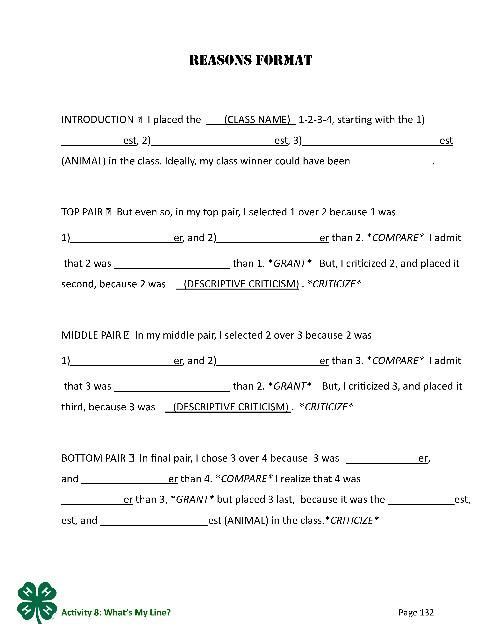
Taking Notes Handout
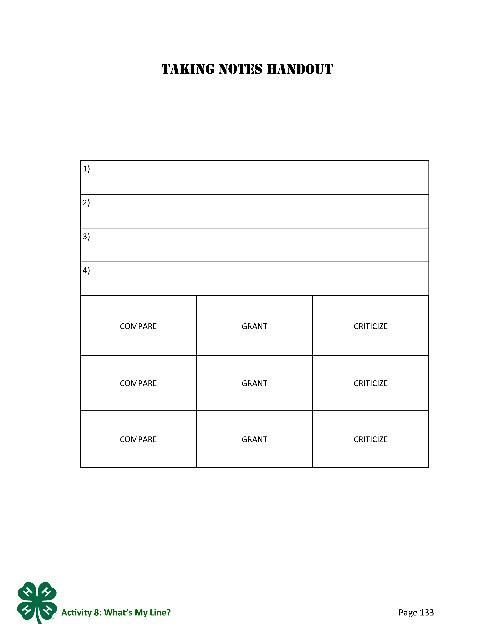
Taking Notes Handout with Animal Descriptions
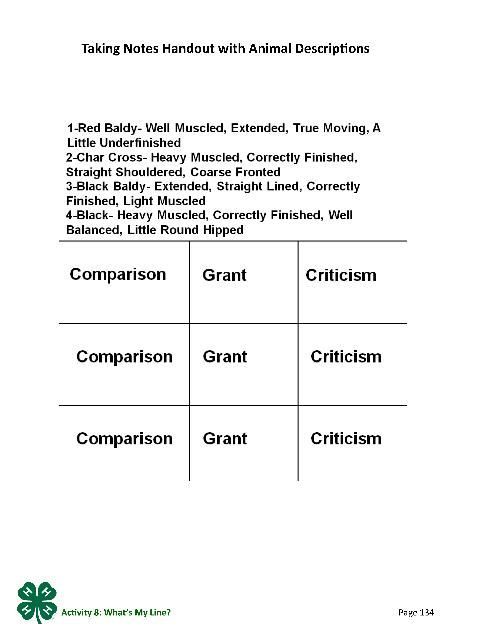
Sample Notes
